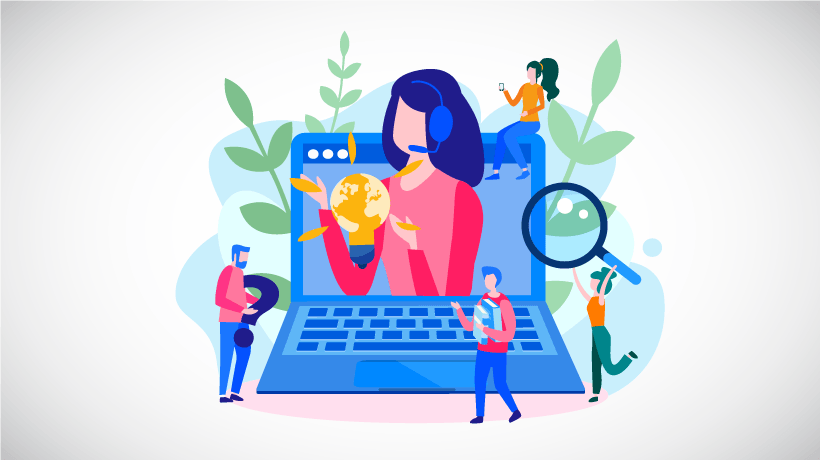Imagine operating your business without communicating with your customers in any way, shape, or form.
You can’t talk to them directly.
You can’t publish information and hope they happen upon it.
You can’t even label your products, as this would be communicating indirectly with anyone who walks by it on the shelf.
Worse yet:
You can’t answer any of the many (many) questions they likely have about what the heck is going on over at your headquarters.
It’s…absurd to think about, no?
Communicating with your customers is so vital to your business that it’s truly absurd to think of not doing it.
Which is exactly why you need to get it right.
Here, we’ll dig into everything you need to know about customer communication including:
- What customer communication is
- Why effective customer communication is important
- Qualities of effective customer communication
- Challenges and pitfalls of communicating with customers
- Best practices for customer communication in the digital age
Let’s get started.
What is Customer Communication?
Customer communication refers to all direct or indirect interactions and information exchanges that occur between a brand and its individual customers.
Generally, customer communication falls into one of three categories:
- Marketing messages, from email newsletters and social media posts to push notifications and on-site popups
- Transactional notifications, such as payment receipts, shipping information, and returns processes
- Customer support, both proactive and responsive
This is not to say that customer communication should be siloed in this manner.
In fact, quite the opposite:
Today, progressive brands are taking a more holistic approach to customer communication management across the board. As we’ll discuss, this means equipping all audience-facing departments and team members to deliver the exact info customers need at every touchpoint in their journey.
Why is Effective Customer Communication Essential?
Okay, so the overarching answer to the above question is pretty self-explanatory:
If you’re unable to effectively communicate with your customers, you’ll be unable to market to them, sell to them, or provide support to them at all.
(They likely won’t even become your customers in the first place, if we’re being honest.)
At any rate, let’s dig a bit deeper into the key reasons effective customer communication is so critical to your business’ success.
Enhances Overall Customer Experience
Good communication keeps your customers informed at all times — both the good and the bad.
Which is exactly what they expect from the brands they do business with today.
And that just makes sense:
When things are going well, giving them even more good news and useful information can only improve their situation. When they’re in need of assistance, providing reassurance — along with proper guidance and instruction — will help get their journey back on the right track.
The other side of this is that it keeps your team informed of where your customers are at in their journey at every turn. This allows you to provide more and more personalized information and support to your loyal customers the longer they stick with your brand.
Boosts Customer Loyalty and Advocacy
Which, if you’re truly helping them succeed at every touchpoint, they almost certainly will.
And your strategic approach to customer communication will help you leverage their trust and loyalty in two key ways.
For one, it’ll be much easier to sell more to your loyal customers — and increase their lifetime value in turn. Not only will you know exactly what to offer them (and how to offer it), but they’ll also be more likely to spend more on a brand they know and trust.
Strategic communication can then help you turn these loyal customers into advocates for your brand. In fact, more than one-quarter of small businesses are focusing on improving communication and customer relationships for this specific purpose.
Informs Product and Service Development
Creating open and always-on lines of communication with your customers means you’ll always know what they’re loving about your products and services — and where they see room for improvement.
This first-hand customer feedback is crucial to your efforts to make continuous improvements to your CX wherever needed. Moreover, you can analyze customer communication and feedback to identify trends and predict your audience’s future needs.
This can again help you streamline individual customer journeys, and can potentially lead you to make more foundational improvements to your overall operations.
Differentiates from Competitors
Effective customer communication helps you differentiate your brand from your competitors in the eyes of your target audience — in a few key ways.
For one, regular communication with your customers provides ongoing opportunities for your brand’s voice to shine through. This is key for brand recognition and recall, and for positioning your brand as a unique entity within your industry.
Secondly, it allows you to regularly showcase the value of your products, services, and overall brand. This ensures your customers are informed and fully understand the value you bring to the table — and why it’s beyond that which your competitors have to offer.
Finally, a customer-centric approach to communication can be the thing that differentiates your brand from your competition. With the landscape of most industries changing continuously, figuring out how to best communicate with your customers can earn your brand a progressive and innovative reputation.
Drives Business Growth
To review, a stellar customer communication strategy will help you:
- Keep your customers successful, satisfied, and engaged
- Grow your customer base through advocacy and brand reputation
- Make critical improvements to your products, services, and customer experience
If all of this is going swimmingly, growth for your business is right around the corner.
While there’s obviously much more to business growth than good communication, it’s part of what will allow you to make laser-focused improvements that have a positive impact on your customers. And, it will enablee you to keep your customers in the loop as you grow your business and make the changes needed to better serve your audience.
Qualities of Effective Customer Communication
Customer communication can look very different depending on how and why it’s happening.
In all cases, though, it needs to adhere to the following principles in order to be effective and to provide optimal value to the customer.
Consistency
A consistent approach to customer communication is essential to create a cohesive brand experience for your audience.
As OpenText explains:
“Businesses who offer consistent and meaningful interaction can forge bonds with their customers that are far stronger than the kind of shallow attachments static and impersonal messages can manage.”
This, for one, means there needs to be a sense of uniformity in your tone, style, and overall messaging across all communication channels. Moreover, you’ll need to maintain this tone, style, and approach even as you tailor your messaging for different purposes.
Clarity
Ensuring clarity and precision in every message exchanged with your customers minimizes confusion and keeps them moving closer toward their next purchase or milestone.
Conversely, a lack of clarity can confuse the customer and stop them in their tracks. At best, this leads to wasted time and energy — and missed opportunities to engage productively with them. At worst, it can cause them to leave your brand behind in favor of a more clear and helpful solution.
As we’ll get to, ensuring clarity in your messaging typically means being concise and avoiding unnecessary use of jargon. Basically, never say more than you need to — or risk losing your audience completely.
Empathy
Effective customer communication showcases a genuine understanding of and compassion for your customers’ situation at every touchpoint.
This is perhaps most important for ensuring your customers know you see them as more than a number — and also for delivering the personalized experience modern consumers typically expect from brands today.
To be sure, packing your messaging with empathy means more than using kind words and paying lip service. More importantly, it's about tailoring each conversation to the situation: that is, the customer's needs, their mood, and the myriad other factors that play into authentic interpersonal engagements.
Proactivity & Responsiveness
Proactivity and responsiveness are two sides of the same coin when it comes to customer communication.
Proactive customer communication is crucial to facilitating engagement from new and existing customers alike. Delivering updates, offers, and other relevant information keeps your brand top-of-mind, and creates ongoing opportunities to do more for (and sell more to) your audience.
The deeper part of proactive communication lies in doing the legwork needed to engage effectively with your audience. Understanding who they are and why they do business with your brand allows you to inject personalized value into every customer interaction.
Responsiveness, on an individual level, is about responding to those that reach out to your team effectively and efficiently so they can continue on toward their goal. Zooming out, a responsive approach to customer communication allows you to pivot your messaging based on customer and industry sentiment over time.
Accessibility & Timeliness
Accessible and timely customer communication reinforces your brand’s empathy and keeps your users on the fast track to success.
This means delivering proactive messages on the most practical, appropriate, and preferred channels, and doing so when the recipient is most likely to engage with them. And, it means allowing for incoming messages on these channels at all times — and, again, responding to them as efficiently and effectively as possible.
Challenges of Customer Communication
Needless to say, communicating with your customers — on both an individual and audience-wide basis — is not easy.
But knowing the key challenges of effective customer communication is the first step to overcoming them.
Offering Consistent Omnichannel Communication
Communicating consistently and seamlessly with your customers across multiple channels becomes increasingly difficult as you spread to new platforms, and/or as your customer-facing teams grow in size.
As digital natives take over the bulk of the consumer population, this is becoming an evermore pressing concern:

Unfortunately, OpenText reports that a not-so-seamless experience “is at the root of (younger consumers’) dissatisfaction with the current state of digital communications.” On the bright side, addressing this issue within your own organization will almost certainly put you far ahead of the status quo.
Maintaining Personalization at Scale
As shown above, the consumer of today and tomorrow expects personalized messaging and experiences from the brands they do business with — and they aren’t getting it.
And their expectations are only increasing as time goes on.
While major companies can afford to provide fully personalized interactions at crucial moments, this is one area where growing businesses can easily fall behind. Even with all the necessary customer data at your team’s fingertips, putting all the pieces together in real-time can be a logistical nightmare as your audience grows in size and complexity.
(The silver lining here is, of course, the advent of generative AI to help with customer service.)
Digital Transformation and Compliance
Adare’s report also found that up to three-fourths of small businesses are struggling with digital transformation of customer communication.
(This, despite the fact that digital transformation is and has been a top priority for most teams since at least the start of the pandemic.)
In some cases, teams are having trouble integrating emerging communication tools with their existing legacy systems. On the more progressive side, those who have shifted away from legacy systems completely still face the challenge of setting up and learning an entirely new system — all while maintaining full communications with their audience.
Relatedly, more than one-third of companies admit they need to do more to protect their customers’ privacy when communicating with them. This is especially true as teams navigate new channels and tools while aiming to deliver a fully cohesive experience to their customers.
Customer Communication Best Practices
Now that we understand all that effective customer communication involves, let’s talk about what you need to do to make it happen.
1. Develop a Customer Communication Style and Style Guide
A comprehensive communication plan is necessary to ensure every customer interaction reflects the brand’s identity and values — and provides a cohesive experience to the customer as expected. To ensure this, you'll want to create a style guide to help standardize your communication efforts across every customer touchpoint.
Some of the key points to define within your style guide include:
- Brand Voice and Tone: Define how your team will approach and communicate with customers in different situations
- Language and Terminology: Specify how your team should use jargon, colloquialisms, and other such terminology when engaging with customers
- Formatting and Structure: Define how different branded media and communications should be organized and presented to the intended audience
- Use of Visuals and Multimedia: Identify what media types and assets can or must be used in certain communications; also, what media should not be allowed in some circumstances
- Channel-Specific Guidelines: Define any unique stipulations team members must adhere to when communicating with customers on certain channels
Be sure to provide your team with clear examples for each section, especially when focusing on more tacit info like voice and tone. Similarly, make sure your team understands which parts of the guide they must adhere to at all times — and where they’re allowed to go off-script as needed to best serve the customer.
2. Strategic and Intentional Use of Technology
Modern technology is on the front- and backline of customer communication — so you need to be sure you’re using it effectively.
The main tools you’ll want to have at your disposal include…
Customer Communication Management Software
A customer communications management tool centralized and streamlines comms across all used channels.

With a CCM in place, teams can automate routine customer communications — and can jump into person-to-person engagements equipped with the information they need to help the customer out. Many CCM tools also use automated data analysis to identify opportunities for proactive engagement and further communication with your customers.
Customer Relationship Management Software
CRM systems keep all customer info — contact details, preferences, and engagement history — in a centralized location for your teams to access as needed.

This gives all teams a comprehensive view of every customer they interact with. In turn, they can tailor communications to the individual’s needs and expectations — ideally leading to optimal outcomes with each engagement.
Helpdesk Software
Helpdesk software facilitates all customer service and support instances, from initial intake to complete resolution.

These tools allow your support staff and customers to communicate in real-time and asynchronously throughout a service instance (and beyond). Integrating your helpdesk and CRM software is crucial, as it ensures your support staff has everything they need to provide a top-notch experience to the customer.
Social Listening Software
Social listening software is essential for continuous improvement of your approach to customer communication.

With social listening software, you’ll be able to track customer sentiment, identify brand mentions, and jump into relevant conversations happening online on third-party platforms. You can then use the information gleaned from these engagements to help inform your customer communication management moving forward.
Knowledge Base Software
Knowledge base tools like Helpjuice can all aid in customer communication in multiple ways.

Your customer-facing knowledge base, for one, provides open access to most anything your audience needs to know about your products, services, and company. While the self-service aspect of your knowledge base is beneficial in itself, you’ll also be equipping your customers to have more effective and impactful communications with your team in the future.
In the same vein, your internal KB, wiki, and/or intranet platform helps your team optimize customer communications on all fronts. With the right info always at your fingertips, you’ll always be able to deliver as needed.
3. Offer Real-Time and Asynchronous Communication Options
Creating truly open lines of communication with your customers means offering them ways to engage with your brand in real-time and asynchronously.
While customer preference is a factor here, it’s much more important to point customers to the option that is most practical for their current purposes.
Typically, real-time comms options — phone, live chat, etc. — are best-suited for urgent and complex issues that may require hands-on assistance. For less-pressing issues of varied complexity, email and helpdesk messaging can help avoid unnecessary bottlenecks for your support team.
(And, again, offering self-service options is a proactive way of communicating the info your customers need — before they even know they need it.)
4. Use Automated and Authentic Engagements Appropriately
Customer communication doesn’t always have to involve a person on your company’s end, either.
That said, you do need to know when the use of chatbots and generative AI is acceptable — and when it can potentially lead to disaster.
Generally speaking, you’ll want to reserve AI comms for simple engagements where there’s not much at stake for either the customer or your business.
Examples include:
- Inquiries about the ordering process
- Delivery notifications
- Basic product assistance and instruction
As issues become more complex and/or emotionally-charged, a human service rep will be needed to effect a positive outcome. Similarly, while automation can be used to reach out to customers at critical points in their journey, having a human rep on-hand will help you get the most out of these opportunities.
5. Create Feedback Loops for Continuous Engagement and Improvement
When communicating with your customers, one of your main goals is to ensure future communication takes place, as well.
(And for these subsequent engagements to be better and better than the previous one!)
Making this happen requires a two-pronged approach that involves:
- Soliciting, eliciting, and otherwise capturing feedback with every engagement
- Actively improving your approach based on this feedback and other relevant data
Soliciting feedback keeps the conversation going — allowing you to build on the customer’s experiences and deliver additional value to them. Similarly, paying close attention to the customer’s words and actions at all times will keep you informed of their needs and expectations moving forward.
6. Optimize Knowledge Management
As we’ve touched on, effective customer communication relies on your team’s ability to find and deliver the right info to the right audience, at the exact right time.
Which means your knowledge management operations need to be absolutely flawless.
With a comprehensive approach to KM, your customer-facing teams will always know:
- Where to look for when in need of specific information
- How to best deliver the necessary info to the customer
- How to best capture any new information they glean from the customer
So, you’ll not only optimize each individual engagement and conversation you have with your customers; you’ll also make ongoing improvements to your approach to customer communication, overall.
Helpjuice: A Foundation for Effective Customer Communication
Looking for a knowledge base tool that will help you ramp up customer communication on both the front and backend?
Enter: Helpjuice.
With our comprehensive KB solution, you can create both internal and customer-facing content to keep your team and audience as informed as ever. Your customers will benefit from having a multimedia-rich, self-service at their disposal — while your staff will be equipped to deliver top-level value to them at every touchpoint.
And, it’s free to try for 14 days!
Ready to get started? Schedule a demo with Helpjuice’s team today.





